Understanding Pimples: Causes, Types, and Effective Treatment Strategies
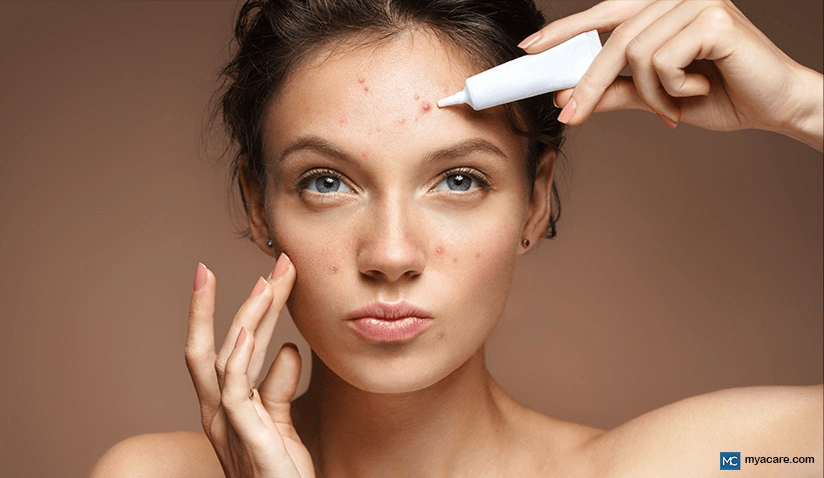
Medically Reviewed & Updated by Dr. Rosmy Barrios - August 1, 2024
Pimples are a common skin condition that can be unsightly and frustrating. Also known as acne, pimples can appear at any time due to a variety of causes, some of which are genetic or hormonal. You can usually spot pimples on the face, neck, chest, and back, yet more advanced types may pervade any area of the body. They may be unnoticeable or may be itchy, red, swollen and sore.
There are several types of pimples, each with its own characteristics, causes, and management techniques. In this article, we’ll explore the causes of acne alongside the different types of pimples, including blackheads, whiteheads, papules, pustules, nodules, and cysts. We’ll also provide insights on how to get rid of pimples with effective prevention tips and treatment options. By the end of this post, you’ll have a better understanding of pimples and how to keep your skin clear and healthy.
What Causes Pimples?
Pimples are caused by clogged hair follicles and occur due to excessive oil production, a build-up of dead skin cells, skin inflammation and bacterial infections.[1]
Clogged follicles lead to the formation of various types of pimples, each of which depend upon unique inflammatory triggers, the depth at which the follicle is clogged and the degree to which it’s infected. In some cases, mild to moderate acne can go on to form moderate to severe acne. In moderate to severe acne, the pore walls break down, leading to more inflammation, redness and worse infections. This is why some types of pimples hurt more than others.
Most acne-related infections arise due to an overabundance of normally present skin microbes such as Propionibacterium acnes and Pityrosporum ovale. Chronic acne is associated with resistant variants of skin bacteria such as cutibacterium acnes, type IC. While C. acnes is a bacteria associated with acne, acne is not primarily an "infection" but an inflammatory response. The blockage of pores by excess sebum and dead skin cells creates an environment where C. acnes can proliferate, but the condition is more complex than merely an infection by skin microbes. Acne is primarily an inflammatory condition influenced by hormonal changes, sebum production, and the immune response, rather than a simple bacterial infection
To prevent acne, it’s important to keep your skin clean, maintain a proper skincare routine and avoid touching your face with unwashed hands.
Acne Triggers
The following factors are known to trigger acne and play a significant role in its development[2]:
- Hormonal Changes. Hormone fluctuations can cause an increase in sebum (skin oil) production, which can clog pores and lead to acne. Androgens are especially implicated. This is why acne is common during puberty, adolescence, the week leading to menses, pregnancy, menopause and in those with hormonal disorders.
- Stress. Pimples can form in response to stress due to the way cortisol causes an increase in androgen production. These hormones stimulate the sebaceous glands and lead to acne.
- Skin Inflammation. If the skin is overly inflamed or damaged, it can cause micro lesions (tiny cuts) in the skin’s pores. These can easily trap dead skin cells and oil, as well as become infected. Inflammation also hinders the wound-healing process, which often contributes towards perpetuating chronic acne.
- Excessive Sweating. Breakouts are commonly observed after profuse sweating during the hotter months of the year. These are thought to contribute towards acne formation by helping the pores clog with dead skin cells and increasing bacterial growth. Sweat glands can also harbour acne-causing bacteria if immune defenses don’t function optimally.
- Diet and Lifestyle. Factors such as low levels of physical activity, consuming a diet high in sugar or dairy products, smoking, dehydration and not getting enough sleep can contribute to the development of acne. Most of these reduce immune function, promote unbalanced blood sugar levels, increase sebum production and can detract from overall skin health. Oil-heavy cosmetics and too much sun exposure are other lifestyle factors that can lead to pimples.
- Genetics. Genetics can play a role in the development of acne[3]. If your parents had acne or other health conditions that increase the risk, you may be more likely to develop it as well. Genetics may also determine how strong your immune system is and how it responds to skin infections, which can predispose you to chronic acne.
- Skin Conditions. Certain skin conditions, such as rosacea and folliculitis, can cause acne-like bumps on the skin and predispose one to acne due to immune changes and skin barrier dysfunction. It’s important to see a dermatologist if you’re unsure whether your skin condition is acne or something else.
6 Common Types of Pimples
There are 6 common types of pimples that can constitute an acne breakout. All types of pimples require optimal care to prevent future scarring and other blemishes. The following section provides descriptions and pictures that can help to identify and treat different types of pimples.[4]

Mild Acne
Mild acne is the most common type and the most superficial. It consists of the comedones, which are small bumps that appear on the skin’s surface. They can be divided into two main types:
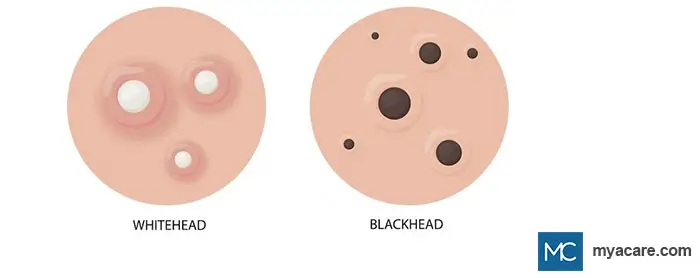
- Whiteheads are closed comedones that are small, round blemishes with a white or flesh-colored center. They are formed close to the skin’s surface in the epidermis. Whiteheads are not normally itchy, sore, red or inflamed and they usually go away on their own with proper care.
- Blackheads are open comedones and are often the smallest types of pimples. Like whiteheads, they’re formed in the epidermis and don’t clog the skin at a deep level. Contrary to popular belief, the black color is not a result of dirt. Instead, trapped dirt, oil, cellular debris and bacteria oxidize when exposed to the open air, giving blackheads their signature color.
How to Treat Mild Acne. Mild acne often goes away on its own with a good skincare routine, hygiene and leading a healthy lifestyle. If persistent, over-the-counter medications and natural remedies will suffice. You don’t need to see a medical specialist for mild acne. If the acne doesn’t resolve, you may wish to consult with a doctor or dermatologist to get a proper diagnosis for moderate to severe acne and receive an optimal treatment plan.
Moderate Acne
Moderate acne is the most common type of chronic inflammatory acne, also referred to as acne vulgaris. This leads to the appearance of larger red pimples that are formed deeper than those seen in cases of mild acne. The two types of moderate acne are reviewed below:
- Papules. Papules are small, red spots that are sometimes raised, are not filled with fluid and can be tender to the touch. They develop when the walls around your pores break down due to severe inflammation.
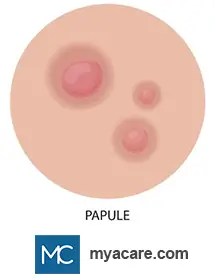
- Pustules. Recognizable by their white or yellow centers surrounded by red, inflamed skin, pustules are larger pimples than whiteheads that are more severely infected. Unlike their smaller counterparts, these may be itchy or feel sore.
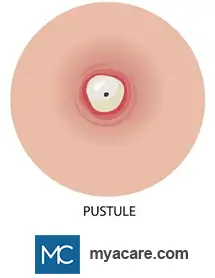
How to Treat Moderate Acne. Some cases of moderate acne require the medical attention of a dermatologist, while other cases can be managed through natural remedies, over-the-counter options and proper skincare.
Severe Acne
Severe acne is the worst type, consisting of nodules and cysts. These often arise together and are referred to as nodulocystic acne. Nodulocystic acne is more prevalent in tropical regions (for unknown reasons) and often gives rise to heavy scarring. You can identify nodules and cysts from the following descriptions[5]:
- Nodules. These can be seen as a more advanced type of papule, being larger, deeper, and more painful. The pore walls are ruptured more with larger lesions present in the dermis, resulting in skin redness due to inflammation. They’re diagnosed as being over 5mm in diameter and feel hard or fibrous. Nodular acne can remain for weeks to months if not treated adequately.
- Cysts. Cystic pimples are the most severe type of acne and can be incredibly painful. They are large, fluid-filled lumps, 7-15mm in diameter, that develop in the deeper layers of skin. While these may contain large lesions beneath the skin that are sore, they’re not as red as nodules. Unlike nodules, they possess a thick, strong wall that surrounds the fluid, making them firm yet movable. They often lead to scarring if left untreated.
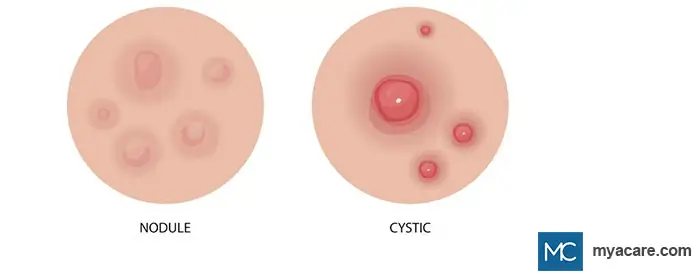
How to Treat Nodulocystic Acne. All cases of nodulocystic acne require the expertise of a dermatologist. The most advanced cases may benefit from multiple treatment options, which typically include a combination of prescription medications, specialized skincare products and dermatologic procedures. After the acne subsides, cosmetic procedures to minimize the appearance of scarring are frequently sought after.
Should You Pop Pimples?
There are no types of pimples that you can pop without risking a worse problem at a later date. Many people try to pop mild to moderate acne, only to perpetuate it or allow for the formation of severe acne and scars. When you pop a pimple, it damages the skin surrounding it and often causes some of the contents to become more deeply lodged. It also allows for the contents to spread on the skin’s surface. This can be painful and stressful, as well as lead to a higher number of infected skin lesions. If a pimple is severe enough and won’t go away, you can opt for acne surgery or comedone extraction at a dermatologist’s office.
Pimple Popping and Skin-Picking Disorder. Although popping a pimple is not a good idea, it might seem like a rewarding one due to the way it triggers dopamine release in a similar fashion to scratching an itch. Some people get addicted to popping their pimples and this can lead to a type of obsessive-compulsive disorder known as skin-picking disorder or excoriation disorder.[6] While young men and male teenagers are more prone to acne, females are more prone to having a pimple-popping addiction. Pimple-popping addiction can be treated by keeping your hands busy instead of popping the pimple and treating the cause to prevent acne from forming.[7]
Pimple Treatment Options
When it comes to treating different types of pimples, one size does not fit all. Tailoring your treatment approach based on the specific type of pimples you're dealing with is essential for effective management.
Natural Remedies for Acne
These can be added or found in natural skincare products designed to treat acne.
- Essential Oils. There are many types of essential oils that help with pimples[8], including tea tree and lavender. These have antibacterial and anti-inflammatory properties that can inhibit acne bacteria, lower skin redness, reduce scar formation and promote optimal skin repair. Other essential oils have nourishing effects that regulate skin oil production, such as jojoba and rosehip oil.
- Natural Astringents[9]. These help counter acne by stripping the skin of excess oil and dead skin, often exhibiting similar anti-inflammatory and antimicrobial properties to the oils listed above. Examples include witch hazel and green tea.
- Mineral Clay[10]. Mineral clay or mud, such as bentonite clay, is known to help suck up excess oil and skin debris, inhibit pathogens and re-mineralize the skin, which keeps it clean, healthy and hydrated.
Does Putting Toothpaste on Pimples Work?
Toothpaste is a tried and trusted home remedy for getting rid of pimples overnight. While it may dry out and shrink a pimple, it’s known to be too harsh for the skin and can promote inflammation that may eventually lead to more acne.[11] If your pimples don’t go away and natural remedies or over-the-counter solutions don’t work, it’s best to consult with a dermatologist about your condition.
Over-The-Counter Solutions
Over-the-counter topical treatments[12] can help to reduce red pimples and prevent further breakouts. They commonly contain antibacterial ingredients that lower inflammation, dissolve dead skin cells and enhance skin repair. Examples include benzoyl peroxide, salicylic acid, alpha hydroxy acids, low-grade retinoids and azelaic acid.
Most products targeting acne will contain up to 10% of one of these ingredients. As they are potent and can cause side effects such as skin dryness, redness and peeling, it’s recommended to start on a low-dose product first. If you have moderate acne, you might prefer to start with a medium dose.
Prescription Medications
If your pimples aren’t going away even after making lifestyle changes and trying an over-the-counter formulation for a number of weeks, then it’s time to see a dermatologist.
Dermatologists work to resolve even the most intensive cases of nodulocystic acne and will prescribe creams, gels, or oral medications while monitoring the patient for signs of improvement. These medications may include prescription retinoids, antibiotics, hormonal treatments and cortisone shots. Your doctor will decide on the best option depending on the underlying cause.
Before agreeing to any prescription, it’s important to ask the dermatologist about the side effects, as some of them can pose lifelong consequences, such as isotretinoin and antiandrogens. Some topical treatments may make your skin more sensitive to light as well.
Dermatologic Procedures
Some forms of acne may not respond to topical or oral treatment options, may give rise to scars or may otherwise benefit from a combination of therapies. In these cases, a dermatologist may perform one of several procedures known to be effective at removing acne and scarring. These include:
- Acne surgery. Also known as comedone extraction, acne surgery is a professional technique for removing pimples and blemishes. A dermatologist makes use of a special tool known as a comedone extractor, which removes the pimple without risking further breakouts. This is often used to get rid of very stubborn blemishes and to enhance oral or topical treatments.[13]
- Light Therapy. There are many types of light therapies capable of improving acne. Most options appear to be effective against papules and pustules, although photodynamic therapy can help to treat cystic acne as well. Light therapy can make the skin sensitive to sunlight afterward. It’s important to discuss whether light therapy is contraindicated while taking other acne prescription medications that may exacerbate the side effects.[14]
- Skin Resurfacing Techniques. Microdermabrasion, chemical peels and laser skin resurfacing all work by removing the top layers of the skin through different mediums. This destroys acne, bacteria and gets rid of superficial scarring.
- Regenerative Procedures. Microneedling and filler injections can promote skin regeneration and do away with scarring. Fillers have the added benefit of reshaping the face in severe cases.
Prevention and Long-Term Care
Preventing pimples goes beyond treating them once they've appeared. Adopting a holistic approach to skincare and making certain lifestyle adjustments can significantly contribute to preventing pimples.
Daily Skincare Habits
Your daily routine should include gentle cleansing, exfoliation and moisturizing that can keep your skin clear and prevent pores from becoming clogged.
It’s essential to use products that don’t create more inflammation in the skin and add to the problem. Opt for a special facial soap that has a pH of 5.5 or soap for sensitive skin. An astringent toner that doesn’t burn can be useful for dissolving dead skin cells and getting rid of excessive oil. Moisturizing is essential after applying an astringent to nourish the skin and keep it hydrated. These effects can be enhanced with skin-supportive nutrients and ingredients that combat acne.
Dietary Considerations
Diet profoundly influences skin health through complex mechanisms involving the regulation of hormones, inflammation and the microbiome. Consuming a balanced diet containing nutrient-rich fruits, vegetables, and whole grains can contribute to hormonal equilibrium and dampen inflammatory responses, helping to support healthy skin free of acne.
On the other hand, types of foods that can cause pimples include dairy, sugary foods, and highly processed snacks. Excessive intake of these might elevate insulin levels and growth factors that promote excess oil and skin cell production.
Lifestyle Adjustments
Managing stress through relaxation techniques and getting adequate sleep can have a positive impact on your skin's health. Staying hydrated is equally important, as it helps maintain your skin's moisture balance. Exercising can help to reduce acne formation through regulating stress, hormones and blood glucose; however, it gives rise to sweating. It’s important to wash after breaking a sweat to prevent a breakout.
Conclusion
Pimples come in various forms, each with their own characteristics and treatment strategies. Understanding the different types of pimples and tailoring your approach to managing them can lead to clearer, healthier skin. Remember that consistency in your skincare routine, seeking professional advice when needed, and making positive lifestyle changes all play a crucial role in keeping pimples at bay. By embracing a multifaceted approach, you can achieve skin that radiates confidence and health.
To search for the best health providers for dermatology in Croatia, Germany, Greece, Italy, Malaysia, Singapore, Slovakia Spain, Thailand, The UAE, the UK, and the US, please use our free search engine.
To search for the best healthcare providers worldwide, please use the Mya Care search engine.
The Mya Care Editorial Team comprises medical doctors and qualified professionals with a background in healthcare, dedicated to delivering trustworthy, evidence-based health content.
Our team draws on authoritative sources, including systematic reviews published in top-tier medical journals, the latest academic and professional books by renowned experts, and official guidelines from authoritative global health organizations. This rigorous process ensures every article reflects current medical standards and is regularly updated to include the latest healthcare insights.

Dr. Rosmy Barrios is an aesthetic medicine specialist with international work experience. She earned her physician diploma at the Universidad Del Norte’s School of Medicine in Barranquilla, Colombia, and her specialty at John F. Kennedy University in Buenos Aires, Argentina. Dr. Barrios is a member of the Pan-American Aesthetic Medicine Association (PASAM) and the Union Internationale de Médecine Esthétique (UIME). She is an expert health writer with keen interests in aesthetic medicine, regenerative aesthetics, anti-aging, fitness, and nutrition. Currently, Dr. Barrios heads the Regenerative Aesthetics department at a renowned Internal Medicine clinic based in Belgrade, Serbia.
Sources:
Featured Blogs



